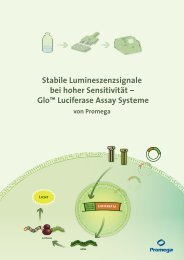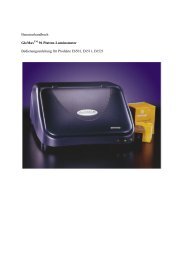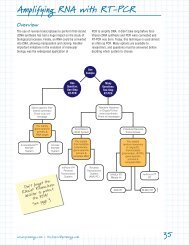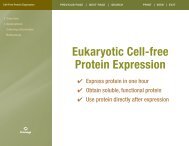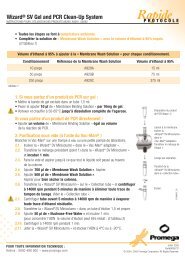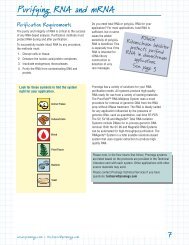pGEM-T and pGEM-T Easy Vector Systems Technical ... - Promega
pGEM-T and pGEM-T Easy Vector Systems Technical ... - Promega
pGEM-T and pGEM-T Easy Vector Systems Technical ... - Promega
You also want an ePaper? Increase the reach of your titles
YUMPU automatically turns print PDFs into web optimized ePapers that Google loves.
8. Troubleshooting (continued)<br />
Symptoms Causes <strong>and</strong> Comments<br />
Less than 10% white colonies with<br />
Control Insert DNA (continued)<br />
Less than 60% white colonies with<br />
Control Insert DNA<br />
Low number or no white colonies<br />
containing PCR product<br />
Ligation reaction has failed. Ligase buffer may DNA have<br />
low activity. The 2X Rapid Ligation Buffer contains ATP,<br />
which degrades during temperature fluctuations. Avoid<br />
multiple freeze-thaw cycles by making single-use aliquots<br />
of the buffer. Use a fresh vial of buffer. To test the activity<br />
of the ligase <strong>and</strong> buffer, set up a ligation with ~20ng of<br />
DNA markers (e.g., Lambda DNA/HindIII Markers, Cat.#<br />
G1711). Compare ligated <strong>and</strong> nonligated DNA on a gel <strong>and</strong><br />
check that the fragments have been religated into highmolecular-weight<br />
material.<br />
T-overhangs have been removed, allowing blunt-ended<br />
ligation of vector <strong>and</strong> giving rise to more blue than white<br />
colonies. Avoid introduction of nucleases, which may<br />
degrade the T-overhangs. Use only the T4 DNA Ligase<br />
provided with the system, which has been tested for<br />
minimal exonuclease activity. Also, use sterile, nucleasefree<br />
water.<br />
Improper dilution of the Rapid Ligation Buffer. The Rapid<br />
Ligation Buffer is provided at a 2X concentration. Use 5µl<br />
in a 10µl reaction.<br />
T-overhangs have been removed, allowing blunt-ended<br />
ligation of vector <strong>and</strong> giving rise to more blue than white<br />
colonies. Avoid introduction of nucleases, which may<br />
degrade the T-overhangs. Use only the T4 DNA Ligase<br />
provided with the system, which has been tested for<br />
minimal exonuclease activity.<br />
Ligation temperature is too high. Higher temperatures<br />
(>28°C) give rise to increased background <strong>and</strong> fewer<br />
recombinants.<br />
Improper dilution of the Rapid Ligation Buffer. The Rapid<br />
Ligation Buffer is provided at a 2X concentration. Use 5µl in<br />
a 10µl reaction.<br />
Ligation incubation is not long enough. Optimal results are<br />
seen with an overnight ligation.<br />
Failed ligation due to an inhibitory component in the PCR<br />
product. Mix some of the PCR product with the positive<br />
control ligation to determine whether an inhibitor is<br />
present. If an inhibitor is indicated, repurify the PCR<br />
fragment.<br />
<strong>Promega</strong> Corporation · 2800 Woods Hollow Road · Madison, WI 53711-5399 USA<br />
Toll Free in USA 800-356-9526 · Phone 608-274-4330 · Fax 608-277-2516 · www.promega.com<br />
Printed in USA. Part# TM042<br />
Revised 12/10 Page 17





